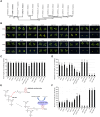The chromatin remodeler ERCC6 and the histone chaperone NAP1 are involved in apurinic/apyrimidinic endonuclease-mediated DNA repair
- PMID: 38367203
- PMCID: PMC11132878
- DOI: 10.1093/plcell/koae052
The chromatin remodeler ERCC6 and the histone chaperone NAP1 are involved in apurinic/apyrimidinic endonuclease-mediated DNA repair
Abstract
During base excision repair (BER), the apurinic or apyrimidinic (AP) site serves as an intermediate product following base excision. In plants, APE-redox protein (ARP) represents the major AP site of cleavage activity. Despite the well-established understanding that the nucleosomal structure acts as a barrier to various DNA-templated processes, the regulatory mechanisms underlying BER at the chromatin level remain elusive, especially in plants. In this study, we identified plant chromatin remodeler Excision Repair Cross-Complementing protein group 6 (ERCC6) and histone chaperone Nucleosome Assembly Protein 1 (NAP1) as interacting proteins with ARP. The catalytic ATPase domain of ERCC6 facilitates its interaction with both ARP and NAP1. Additionally, ERCC6 and NAP1 synergistically contribute to nucleosome sliding and exposure of hindered endonuclease cleavage sites. Loss-of-function mutations in Arabidopsis (Arabidopsis thaliana) ERCC6 or NAP1 resulted in arp-dependent plant hypersensitivity to 5-fluorouracil, a toxic agent inducing BER, and the accumulation of AP sites. Furthermore, similar protein interactions are also found in yeast cells, suggesting a conserved recruitment mechanism employed by the AP endonuclease to overcome chromatin barriers during BER progression.
© The Author(s) 2024. Published by Oxford University Press on behalf of American Society of Plant Biologists.
Conflict of interest statement
Conflict of interest statement. None declared.
Figures




References
-
- Akishev Z, Taipakova S, Joldybayeva B, Zutterling C, Smekenov I, Ishchenko AA, Zharkov DO, Bissenbaev AK, Saparbaev M. The major Arabidopsis thaliana apurinic/apyrimidinic endonuclease, ARP is involved in the plant nucleotide incision repair pathway. DNA Repair (Amst). 2016:48:30–42. 10.1016/j.dnarep.2016.10.009 - DOI - PubMed
MeSH terms
Substances
Grants and funding
LinkOut - more resources
Full Text Sources
Research Materials
Miscellaneous

